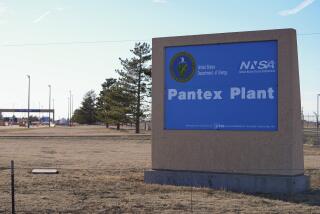Japan’s crisis may have already derailed ‘nuclear renaissance’
Reporting from Washington — The nuclear crisis in Japan, even if authorities are able to bring damaged reactors under control, has cast doubts on the future of nuclear power as a clean-energy solution in the United States and around the globe.
Before the recent events in Japan, the world had seen a surge of nuclear reactor projects, and the talk in Washington was of a “nuclear renaissance” as a way of slowing down climate change and weaning the U.S. from its dependency on petroleum. President Obama made a pitch for nuclear power in January during his State of the Union address, saying it could set “clean energy” standards for the country.
But utilities and their investors were already cautious about committing money toward nuclear projects and insisted on government subsidies and loan guarantees. Now the word is that the emergency at Japan’s Fukushima nuclear complex is likely to dampen the hoped-for renaissance.
As Japanese officials continued their efforts to prevent damaged reactors from a meltdown, the scenes being broadcast worldwide of an explosion at Fukushima and nearby residents being tested for radiation have conjured up images of the panic surrounding the disasters of Three Mile Island in 1979 and Chernobyl in 1986.
The U.S. Nuclear Regulatory Commission over the weekend raced to assure Congress that this country’s 104 reactors — which generate about 20% of the nation’s electricity — were built to withstand earthquakes, tsunamis and other natural phenomena.
The NRC currently has applications for 20 new reactors in the U.S., and four to eight newly constructed units are expected to be operating between 2016 and 2018, said John Keeley, a spokesman for the Nuclear Energy Institute, a trade group. He emphasized that the new reactors would have advanced safety features.
But Peter Bradford, a former NRC commissioner, said Saturday that most of those proposed projects were not viable even before the Japanese crisis because private investors were unwilling to fund them, even with government subsidies.
Experts said it was clear that the situation in Japan would further erode enthusiasm and may even affect applications for continued use of existing plants, such as the San Onofre Nuclear Generating Station in northern San Diego County.
“The reason there have been no new nuclear power plants ordered over the last 30 years is the economics of the industry,” said Rep. Edward J. Markey (D-Mass.), a senior member of the House Energy and Commerce Committee. “Wall Street has been allergic to any investment in nuclear power in the United States.”
But the concerns expressed by scientists, business interests and politicians, not to mention the streets of Europe — thousands marched in an anti-nuclear protest in Germany on Saturday — left no doubt that the emergency in Japan would spark a reassessment of nuclear power.
“I don’t want to stop the building of nuclear power plants, but I think we’ve got to kind of quietly, quickly put the brakes on until we can absorb what has happened in Japan as a result of the earthquake and the tsunami and then see what more, if anything, we can demand of the new power plants that are coming on line,” said Sen. Joe Lieberman (I-Conn.) on CBS’ “Face the Nation.”
In Japan, an explosion occurred at a second nuclear reactor at the Fukushima No. 1 (Daiichi) facility Monday. A day earlier, engineers had begun pumping seawater into the reactor in an attempt to cool its core and stave off a meltdown after the backup cooling system failed. Officials had said hydrogen gas was building up in the reactor building and could cause an explosion similar to that which destroyed the outer building at another reactor at the site Saturday.
Japanese and international agency officials said that there appeared to be little likelihood of a serious public health risk from radiation leaks, at least for the moment. And the efforts to flood the reactors with seawater have averted additional damage to the nuclear fuels inside the cores, even as significant risks lie ahead, nuclear experts said.
“It is still tricky,” said Frank N. von Hippel, a Princeton University physicist, suggesting that the situation could improve. “But the system still is mostly not working.”
For the industry’s immediate future, however, it may already be too late.
Najmedin Meshkati, a USC civil and industrial engineering professor who has specialized in nuclear plant safety for more than 20 years, said, “This accident is going to put the future of nuclear energy into serious question. It has a very rude awakening message. The industry needs to get outside of the box and seriously take into account rare events and situations that are very improbable.
“I don’t know that Japan will have the stomach to approve new nuclear plants,” Meshkati said.
He said that secondary effects of major earthquakes have not received adequate attention, pointing to the vast industrial complexes of oil refineries, chemical plants and nuclear facilities that dot the West Coast of the U.S.
Nuclear energy advocates defended the overall safety of nuclear plants and voiced confidence that the situation in Japan wouldn’t stop the push for new plants in the U.S. “It’s way, way, way too early to be drawing policy conclusions from it,” said Keeley, the Nuclear Energy Institute spokesman.
There are 442 nuclear reactors around the globe, which supply about 15% of the world’s electricity, according to the London-based World Nuclear Assn. Plans are underway to build more than 155 additional reactors, mostly in Asia, with 65 currently under construction, the association said.
With nearly a quarter of the existing reactors, the U.S. is the world’s largest producer of nuclear power, accounting for more than 30% of nuclear generation of electricity.
But the U.S. plants now operating were started before the Three Mile Island accident in 1979, in which a reactor near Harrisburg, Pa., suffered a partial meltdown that resulted in limited radiation release.
One thing that should be kept in mind is that Japan’s Fukushima No. 1 plant, where the biggest problems have been unfolding, is 40 years old, said James Acton, a nuclear expert with the Carnegie Endowment for International Peace.
“The industry will argue that modern reactors have safety features that could have prevented Fukushima,” said Acton, a physicist and nuclear power supporter. “I strongly suspect that claim is correct. I also think it is going to be amazingly difficult to sell that argument to the public.”
Times staff writers Thomas H. Maugh II and Ralph Vartabedian in Los Angeles contributed to this report.
More to Read
Sign up for Essential California
The most important California stories and recommendations in your inbox every morning.
You may occasionally receive promotional content from the Los Angeles Times.












